Intel's Architecture Day 2018: The Future of Core, Intel GPUs, 10nm, and Hybrid x86
by Dr. Ian Cutress on December 12, 2018 9:00 AM EST- Posted in
- CPUs
- Memory
- Intel
- GPUs
- DRAM
- Architecture
- Microarchitecture
- Xe
The Next Generation Gen11 Graphics: Playable Games and Adaptive Sync!
Some of the first words out of the mouth of Raja Koduri about graphics is that Intel has a duty to its one billion customers with integrated graphics to give them something that is useful, and that it is time for Intel to provide graphics which people can actually play games on. Given his expertise on the matter, it shouldn’t sound too far-fetched: more people play games than ever before, and these users want to play no matter what their hardware. To that end, Raja stated that Gen11 graphics is the first step in a new graphics policy to provide the performance and features to let gamers play the most popular games, no matter what implementation.
Gen11: Intel’s first GT2 TFLOPS Graphics
In 2015, Intel launched the Skylake processor with Gen9 integrated graphics. Rather than moving straight to Gen10 the next time around, we were given Gen 9.5 in both Kaby Lake and Coffee Lake, which supposedly draw features from what would have been Gen 10. Actually, the graphics for Intel’s failed 10nm Cannon Lake chip were meant to be called Gen10, however Intel never released a Cannon Lake processor with working integrated graphics, and because Gen11 goes above and beyond what Gen10 would have been, we’ve gone straight to Gen11. Make sense? Well Intel didn’t even bother to acknowledge Gen10 in its history graph:
We will see Gen11 graphics being paired with Sunny Cove cores on 10nm sometime in 2019 according to the roadmaps. However rather than give a detailed architecture layout for the new product, we instead were given a rather high level diagram.
From here we can deduce a few things. We were told that this configuration is the GT2 config, which will have 64 execution units, up from 24 in Gen9.5. These 64 EUs are split into four slices, with each slice being made of two sub-slices of 8 EUs a piece. Each sub-slice will have an instruction cache and a 3D sampler, while the bigger slice gets two media samplers, a PixelFE, and additional load/store hardware. Intel lists Gen11 targeting efficiency, performance, advanced 3D and media capabilities, and a better gaming experience.
Intel didn’t go into too much detail regarding how the EUs are at higher performance, however the company did say that the FPU interfaces inside the EU are redesigned and it still has support for fast (2x) FP16 performance as seen in Gen9.5. Each EU will support seven threads as before, which means that the entire GT2 design will essentially have 512 concurrent pipelines. In order to help feed these pipes, Intel states that it has redesigned the memory interface, as well as increasing the L3 cache of the GPU to 3 MB, a 4x increase over Gen9.5, and it is now a separate block in the unslice section of the GPU.
Other features include tile-based rendering, which Intel stated the graphics hardware will be able to enable/disable on a render pass basis. This will make Intel the final member of the PC GPU vendor community to implement this, following NVIDIA in 2014 and AMD in 2017. While not a panacea to all performance woes, a good tile rendering setup plays well to the bandwidth limitations of an integrated GPU. Meanwhile Intel's lossless memory compression has also improved, with Intel listing a best case performance boost of 10% or a geometric mean boost of 4%. The GTI interface now supports 64 bytes per clock read and write to increase throughput, which works with the better memory interface.
Coarse Pixel Shading, Intel's implementation of multi-rate shading and similar in scope to NVIDIA’s own Variable Pixel Shading, is also supported. This allows the GPU to reduce the amount of total shading work required by shading some pixels on a less than 1:1 basis. Intel showed two demos for CPS, where pixel shading was reduced either as a function of object distance from camera (so you do less work when things are further away), or reduced as a function of how close the object is to the center of the screen, designed to help features like foveated rendering for VR. With a 2x2 pixel stencil applied – meaning only one pixel shading operation was done per block of 4 pixels – Intel stated a ~30% increase in frame rates in supported games. Unfortunately this needs to be applied on a game-by-game basis in order to prevent significant image quality losses, so the performance gains won't be immediate or universal.
For the media block, Intel says that the Gen11 design includes a ground up HEVC encoder design, with high quality encode and decode support. Intel cited the fact that its media fixed function units are already used in the datacenter for video processing, and home users can take advantage of the same hardware. Intel also stated that by using parallel decoders it can either support concurrent video streams or they can be combined to support a single large stream, and this scalable design will allow future hardware to push the peak resolutions up to 8K and beyond.
The highlight of the display engine is support for Adaptive Sync technologies. We were told that it was announced back at the launch of Skylake, but now it is finally ready to go into Intel’s integrated graphics. This goes in hand with HDR support due to its high-precision data path.
One thing in this presentation that Intel didn’t mention directly is that Gen11 graphics would appear to have Type-C video output support, potentially indicating that Intel has integrated the necessary mux into the chipset itself, removing another IC from the motherboard design.


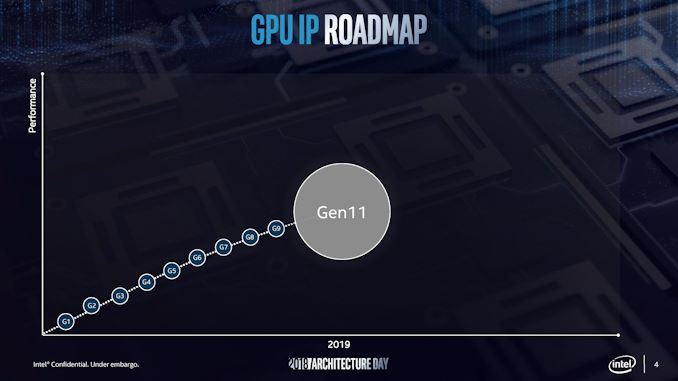
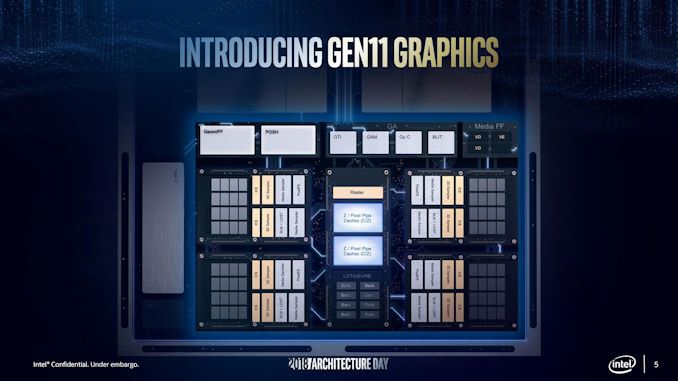
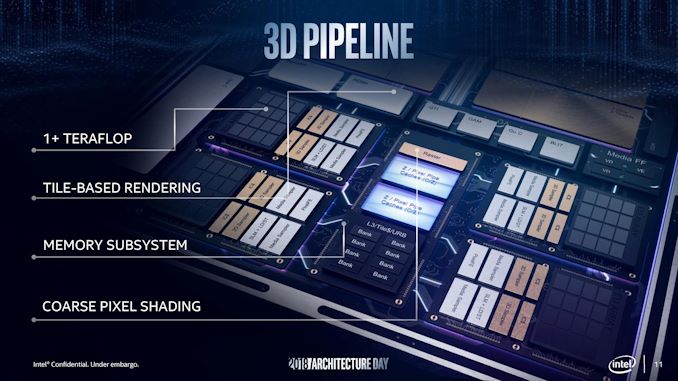
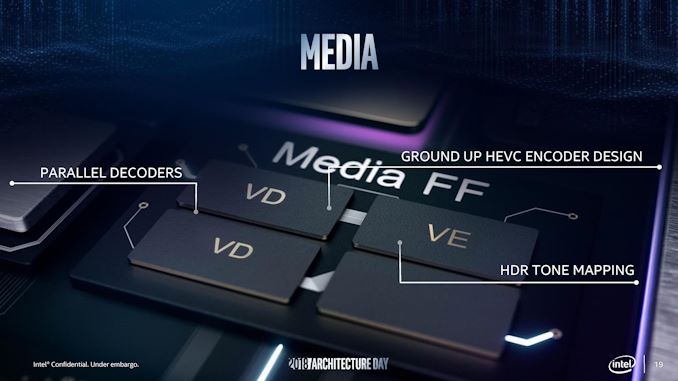
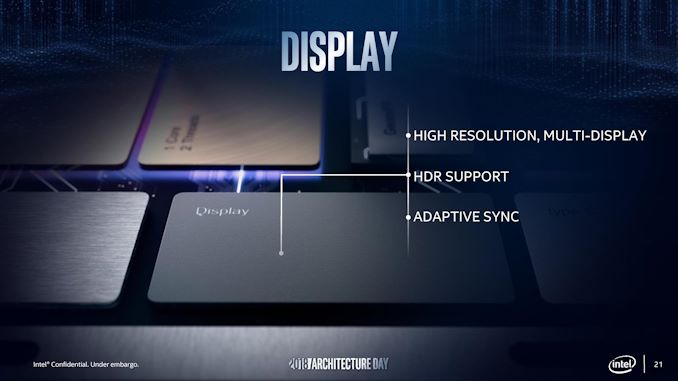
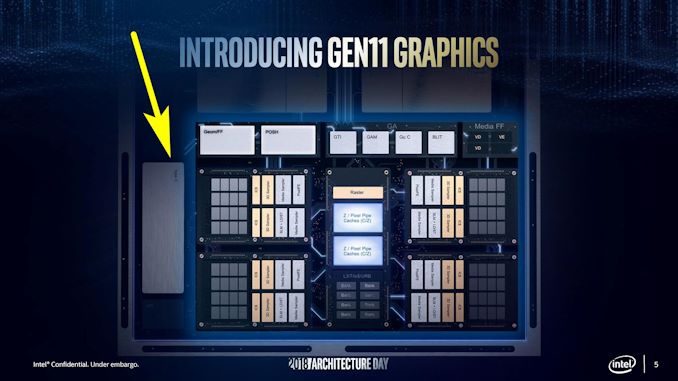








148 Comments
View All Comments
iwod - Thursday, December 13, 2018 - link
Except external GPU.Icehawk - Thursday, December 13, 2018 - link
The number of those sold can be counted on one hand. Ok, maybe two,In all my years I've used a FW cable exactly once.
I've seen a total of two thunderbolt cables, our Mac guy had them for some crap he was doing. IOW, dead just like FW. Proprietary stuff just doesn't tend to last long in an open, commodity, market when equivalents are available for free or pennies on the dollar.
dampf - Wednesday, January 2, 2019 - link
Because nobody knows about it. I'm sure there is a big market for that, just connect a GPU to your laptop via thunderbolt 3 and enjoy high end gaming!johannesburgel - Thursday, December 13, 2018 - link
Nonsense, it's exactly the other way around. Everything is converging on PCI Express. Every peripheral which can actually profit from USB3 speeds would be better off with a direct PCI Express connection instead, and Thunderbolt can do that. USB3 on the other hand requires protocol conversion on both ends of the cable. Instead of being able to just plug a normal GPU, an off-the-shelf NVMe SSD or any other standard device into an external enclosure, without any hardware or driver adaptions, people have to come up with USB3 interface chips and special USB variants of every device.USB3 never had a reason to exist.
HStewart - Thursday, December 13, 2018 - link
I guess you have never truly experience Thunderbolt - it has 40G rate compare USB 3.0 and currently drives a doc - powering multiple monitors plus multiple devices - also remember that it is a superset of USB C Gen 2.Not to mention it has external GPU via PCIe.
HStewart - Thursday, December 13, 2018 - link
TB3 is open up - I believe I saw some foreign TB3 controller out there - but there maybe support issue -Gc - Thursday, December 13, 2018 - link
_eX
looks like it stands for x'ellerator, for many hardware accelerator markets, not just gaming.
Visually, it looks like a tuxedoed figure skater X holding up Microsoft's 'e'.
Samus - Thursday, December 13, 2018 - link
“a customer asked for a product of about this performance but with a 2 mW standby power state. In order to do this, Intel created and enhanced a number of technologies inside the company. The final product is apparently ideal for the customer, however the chip will also be made available for other OEMs.”Clearly Apple.
StrainedDig4 - Thursday, December 13, 2018 - link
Is there a reason when I expand the text screen your video Ads pop up onto the screen, refuse to quit and obscure 1/4 of the display? Are your readers displeasure less important than advertising dollars? I don’t read your articles to buy things, I have Amazon for that, I read to become more informed. Kindly let me know why your pages have become Tomshardware.com lookalikes...ajc9988 - Thursday, December 13, 2018 - link
advertising dollars keep the lights on and pay the salaries of the authors of these articles. Without ads, you don't get to read the content for pleasure, and then it all is a moot point, now isn't it. With that said, could you give constructive criticism on how they could make it less intrusive while still accomplishing the same goal?